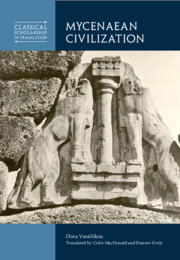Refine search
Actions for selected content:
6455 results in Classical Archaeology
4 - The Late Helladic III Period
-
- Book:
- Mycenaean Civilization
- Published online:
- 19 December 2025
- Print publication:
- 15 January 2026, pp 238-427
-
- Chapter
- Export citation
Acknowledgements
-
- Book:
- Mycenaean Civilization
- Published online:
- 19 December 2025
- Print publication:
- 15 January 2026, pp xvi-xvi
-
- Chapter
- Export citation
Index
-
- Book:
- Mycenaean Civilization
- Published online:
- 19 December 2025
- Print publication:
- 15 January 2026, pp 702-730
-
- Chapter
- Export citation
Abbreviations
-
- Book:
- Mycenaean Civilization
- Published online:
- 19 December 2025
- Print publication:
- 15 January 2026, pp 581-595
-
- Chapter
- Export citation
Further Reading
-
- Book:
- Mycenaean Civilization
- Published online:
- 19 December 2025
- Print publication:
- 15 January 2026, pp 596-670
-
- Chapter
- Export citation
8 - The Mycenaean World
-
- Book:
- Mycenaean Civilization
- Published online:
- 19 December 2025
- Print publication:
- 15 January 2026, pp 513-538
-
- Chapter
- Export citation
9 - The End of Mycenaean Civilization
-
- Book:
- Mycenaean Civilization
- Published online:
- 19 December 2025
- Print publication:
- 15 January 2026, pp 539-565
-
- Chapter
- Export citation
3 - The Late Helladic II Period
-
- Book:
- Mycenaean Civilization
- Published online:
- 19 December 2025
- Print publication:
- 15 January 2026, pp 179-237
-
- Chapter
- Export citation

Clothing Bodies
- Weaving and Textiles in the Aegean Bronze Age
- Coming soon
-
- Expected online publication date:
- January 2026
- Print publication:
- 28 February 2026
-
- Element
- Export citation

Mycenaean Civilization
-
- Published online:
- 19 December 2025
- Print publication:
- 15 January 2026

Social Change across the End of the Aegean Bronze Age
-
- Published online:
- 10 December 2025
- Print publication:
- 08 January 2026
-
- Element
- Export citation
Figures
-
- Book:
- The Archaeology of the Cyclades in the Roman and Late Antique Periods
- Published online:
- 23 October 2025
- Print publication:
- 06 November 2025, pp xv-xviii
-
- Chapter
- Export citation
Dedication
-
- Book:
- The Archaeology of the Cyclades in the Roman and Late Antique Periods
- Published online:
- 23 October 2025
- Print publication:
- 06 November 2025, pp v-vi
-
- Chapter
- Export citation
Appendices
-
- Book:
- The Archaeology of the Cyclades in the Roman and Late Antique Periods
- Published online:
- 23 October 2025
- Print publication:
- 06 November 2025, pp 157-234
-
- Chapter
- Export citation
Chapter Four - Sanctuaries and Churches
-
- Book:
- The Archaeology of the Cyclades in the Roman and Late Antique Periods
- Published online:
- 23 October 2025
- Print publication:
- 06 November 2025, pp 85-112
-
- Chapter
- Export citation
Chapter Two - Life, Death and Settlement Patterns
-
- Book:
- The Archaeology of the Cyclades in the Roman and Late Antique Periods
- Published online:
- 23 October 2025
- Print publication:
- 06 November 2025, pp 28-56
-
- Chapter
- Export citation
Appendix 1 - Gazetteer of Roman and Late Antique Sites on the Cyclades
-
- Book:
- The Archaeology of the Cyclades in the Roman and Late Antique Periods
- Published online:
- 23 October 2025
- Print publication:
- 06 November 2025, pp 157-224
-
- Chapter
- Export citation
Acknowledgements
-
- Book:
- The Archaeology of the Cyclades in the Roman and Late Antique Periods
- Published online:
- 23 October 2025
- Print publication:
- 06 November 2025, pp xxi-xxii
-
- Chapter
- Export citation
Maps
-
- Book:
- The Archaeology of the Cyclades in the Roman and Late Antique Periods
- Published online:
- 23 October 2025
- Print publication:
- 06 November 2025, pp xix-xx
-
- Chapter
- Export citation
Contents
-
- Book:
- The Archaeology of the Cyclades in the Roman and Late Antique Periods
- Published online:
- 23 October 2025
- Print publication:
- 06 November 2025, pp vii-xiv
-
- Chapter
- Export citation
